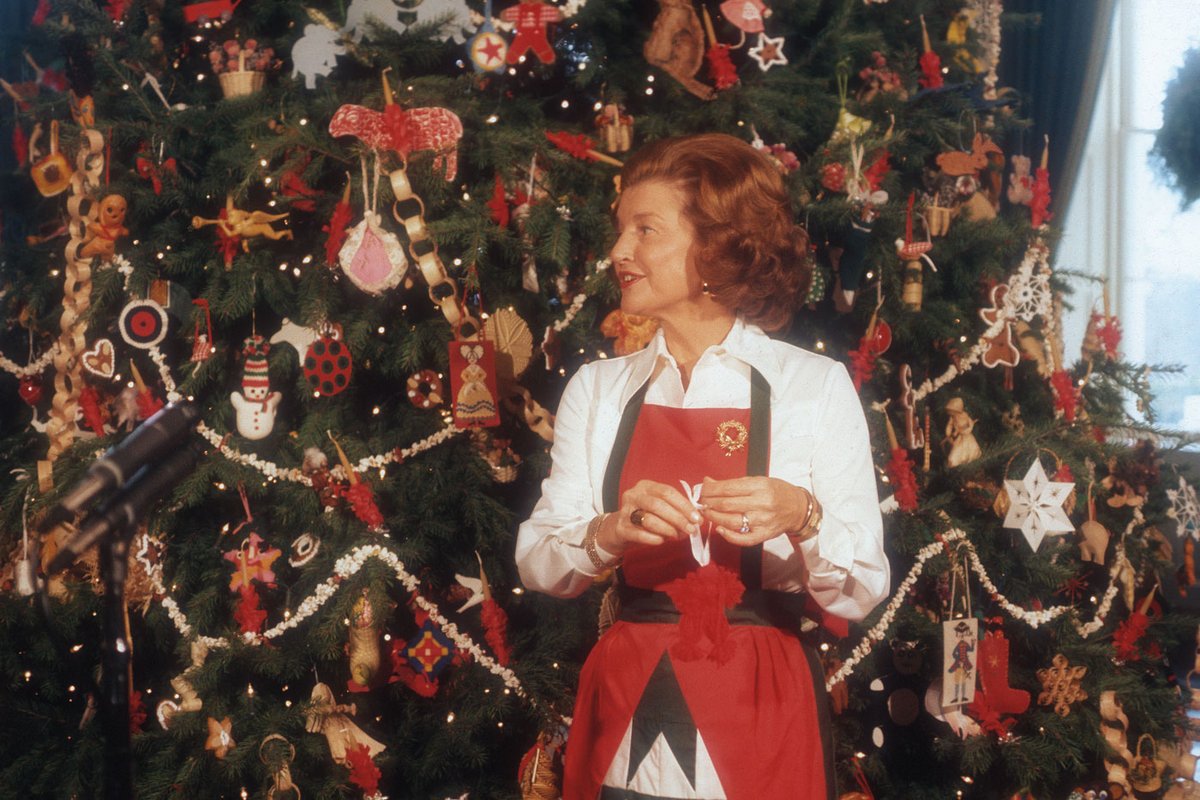
From Williamsburg to Washington
Betty Ford asked Colonial Williamsburg to decorate the White House Christmas tree
In 1975, with America’s Bicentennial just around the corner, first lady Betty Ford wanted an old-fashioned Christmas at the White House. She had in mind a tree with homemade ornaments crafted from inexpensive and natural materials — no foil, no glitter, no sequins, no Styrofoam. She turned to Colonial Williamsburg for help.
She and President Gerald Ford had visited Williamsburg two years before and admired the town’s Christmas decorations. Since Nelson Rockefeller was vice president, the first lady was surely also familiar with the Abby Aldrich Rockefeller Folk Art Collection (AARFAC), which originated with the vice president’s mother.
The first lady’s request wound its way from Carlisle Humelsine, Colonial Williamsburg’s president, to Beatrix Rumford, the director of the museum and an expert on folk art who later served for decades as a Foundation vice president. Rumford turned to employees and volunteers. She sent out a memo with the heading “CHRISTMAS CRAFTERS UNITE — AARFAC NEEDS YOUR HELP!”
The 20-foot-tall fir tree in the White House’s Blue Room would need about 3,000 ornaments. “The idea is to be as original and imaginative as possible in using ‘bits and pieces’ found in home sewing baskets, or by combining such materials as nuts, wood, corn husks, yarn, and wire,” Rumford explained in the memo. “This is a unique and exciting opportunity for nimble fingers and fertile imaginations.”
Fingers and imaginations responded in droves, providing decorations that included figures fashioned from acorns; garlands of popcorn and red peppers; pine-cone angels; animals fashioned from gingham, felt and wire; wreaths, birds and stars made from dough; paper cutouts; and wooden fish, birds and other figures. Most were made by employees and volunteers in Williamsburg, though people across the country also contributed.
In addition to providing the decorations for the tree, the museum lent the White House antique portraits of children, antique toys and carousel figures including a horse whose saddle was decorated with Christmas greens.
In a 2010 oral history, Rumford reminisced about the experience, including not just getting the ornaments made but also transporting them to the White House and decorating the tree. “You felt if you could manage this assignment on six weeks’ notice, you could probably, with the right help...do anything,” she said. It helped that the Fords, Rumford added, “were very warm, very easy people.”
Nearly 100 of the ornament makers from Williamsburg attended the unveiling of the tree and a reception at the White House in December. Among them was seamstress Estelle Stewart, who sent the first lady a poem about the visit. One stanza reads: “The ornaments were hand-made by a special request. / Betty wanted this tree to be different from the rest. / It will always be remembered as the Bicentennial Tree / With 19th-century ornaments that were made by you and me.”
Betty Ford thanked Stewart for the ornaments and the poem. “As the ‘President’s House’ belongs to all our citizens, it is a true pleasure to share the spirit of Christmas with many visitors,” she wrote Stewart. “I was pleased to meet you and others who helped so much.”
President Ford also wrote to thank the many contributors: “Mrs. Ford and I were especially happy that for Christmas, 1975, we were able to share an ‘old-fashioned Christmas’ with the thousands of visitors who came to the White House. Of course, the tree was the center of attention, and decorated as it was, with the very beautiful handiwork of the many people like you who gave generously of their time and talent, it brought joy to all who saw it.”
The decorations generated so much attention that Colonial Williamsburg -collected information from the contributors and in 1976 published Christmas Decorations from Williamsburg’s Folk Art Collection (now out of print), with step-by-step instructions for making ornaments.
Starting on Thanksgiving Day, the original ornaments, which the White House returned after that Christmas, will be on display as part of the Carolina Room exhibit in the Rex and Pat Lucke Gallery of the Art Museums of Colonial Williamsburg.
Williamsburg’s First Christmas Tree
There were no Christmas trees in 18th-century Williamsburg. The town’s first came courtesy of Charles Minnigerode, an immigrant from Germany who lodged with Judge Nathaniel Beverley Tucker and his family at their home on Nicholson Street. In December 1842, Minnigerode showed the Tuckers how Christmas was celebrated in Germany by bringing a small evergreen tree into their house, attaching candles with bits of wire and then lighting the candles. Some early accounts say Minnigerode’s was the first Christmas tree in Virginia and even America. That’s unlikely, however, as previous German immigrants almost surely imported the tradition elsewhere in America.
More from this Issue

